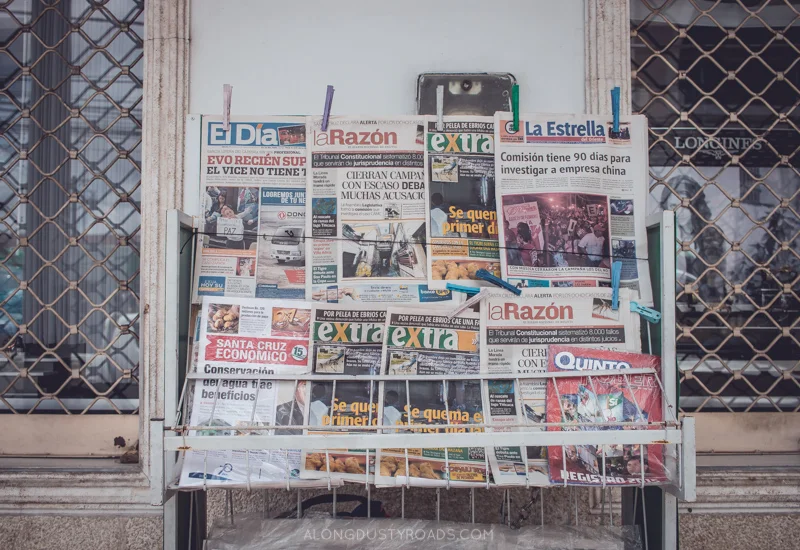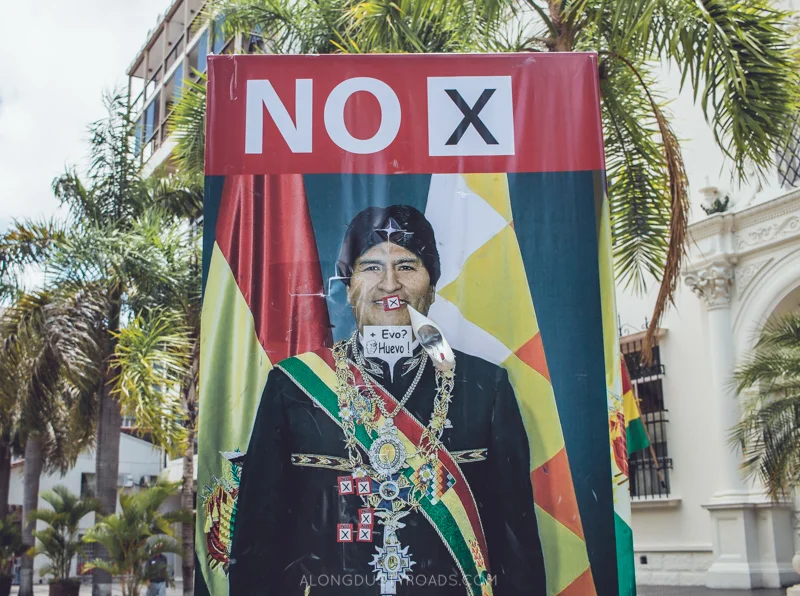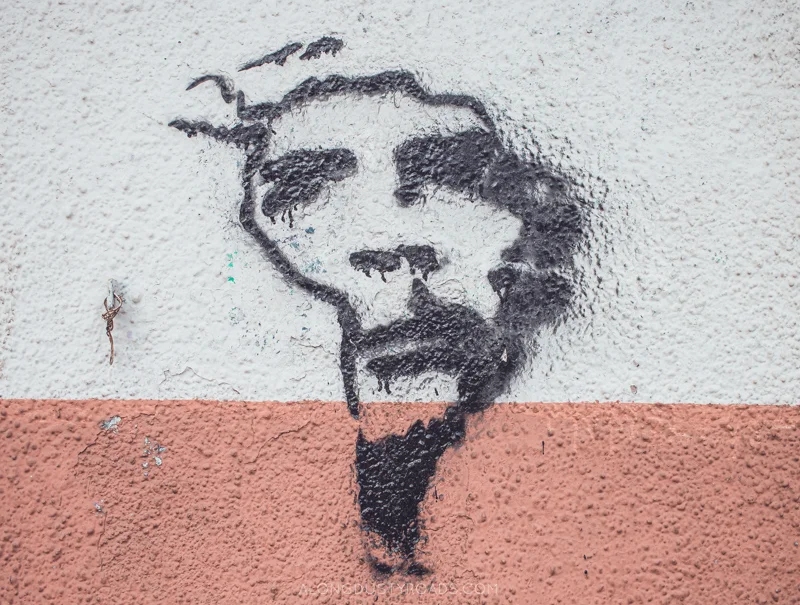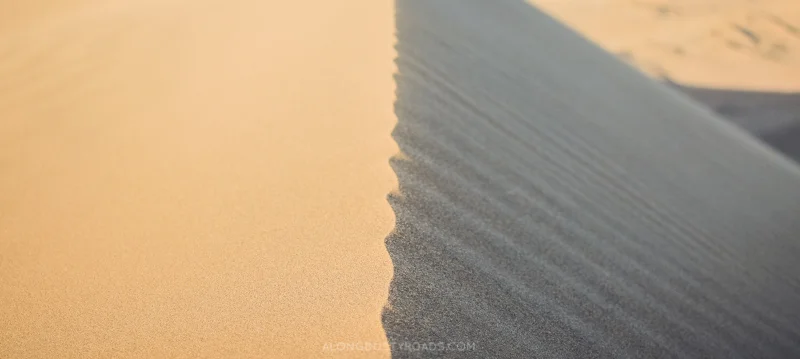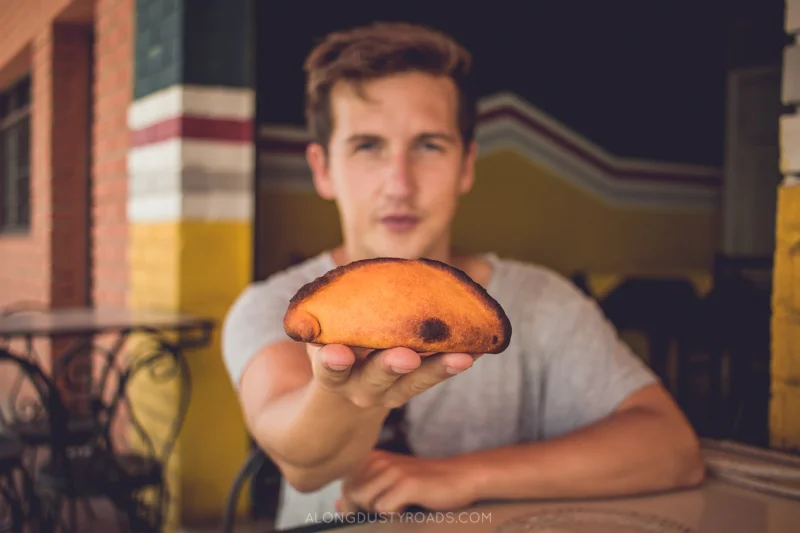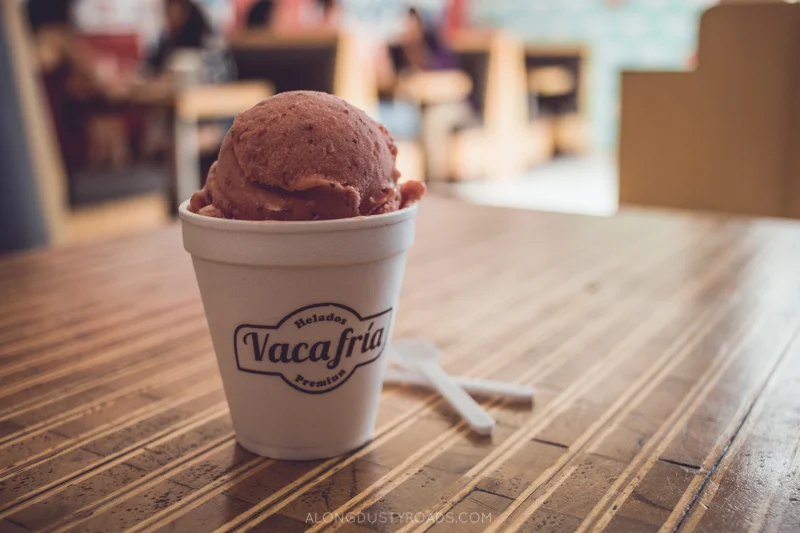Our guide to the best things to do in Santa Cruz, Bolivia.
Santa Cruz is different.
Perhaps that's why a lot of backpackers don't go there. When we think of Bolivia - in the sense of travel - we think of the Salt Flats, we think of Lake Titicaca, we think of bowler-hatted, beskirted women. We think of high snow-capped mountains and cycling down a road named death.
Ok, you may also be thinking about llamas right now.
So, when planning a visit to the country, it's understandable that we may not necessarily think of, or be drawn to discover, a city which doesn't really capture that stereotype of Bolivia that is presented to us in postcards and travel books. Santa Cruz's divergence from the towns and cities of the altiplano is clear from your first few hours there: there are less indigenous residents, a less chaotic life on the streets, traffic lights and pedestrian crossings which are respected, big chains of American-style restaurants focused on primarily attracting the people who live here, not tourists, and a growing number of 'shopping mall experiences'. The architecture of some suburbs we visited would be at home in any city in the world - with gated walls, local play parks, guard dogs and car ownership common (does everyone really need an SUV!?).
Even its altitude is out of sync with the rest of the country at a paltry 416 metres above sea level.
Some Bolivians we spoke to in the west of country don't hold Santa Cruz in high regard; it's viewed with a certain animosity and is the motif of the country's east/west divide. For them, it is the hub of the rich and the elite, the descendants of European colonialists - those who, in their mind, have held Bolivia back for decades for self-interest and self-preservation. If it was only Santa Cruz' vote that matters, Bolivia would never have elected their first indigenous President. One tour guide in La Paz told us that "over there, there's no culture, no identity - only money".
To a limited extent, he is correct. Santa Cruz - the capital of the larger department of the same name - and a number of its residents are, visibly, wealthier than those living in cities like Potosi and La Paz. The reasons are understandable: a significant portion of Bolivia's GDP is derived from the department's industrial and agricultural activities, many companies are headquartered here and so, in turn, almost almost half of foreign investment into Bolivia is concentrated within the city. Cocaine also played a role in the city's riches.
Cruceños themselves would not dispute that their city has been on a different track from the rest of Bolivia for a number of decades. In 2010, a majority of them voted for greater 'autonomy' for the city and department and, during our visit in the lead up to a national referendum on presidential terms it was abundantly clear that this is a place where left-wing Evo Morales is not the most popular politician. A cultural and demographic friction between Bolivia's east and west is therefore certainly not imagined.
However, Santa Cruz offers up a diversity and a lifestyle which is not really visible elsewhere in Bolivia.
Poverty, of course, still exists. In one of the fastest growing cities in the world - residing in one of South America's poorest nations - that shouldn't come as a big surprise. Many come to Santa Cruz from the surrounding countryside in the hope of work and prospects of a better life. And, as ever, not all of them will succeed.
santa cruz for travellers
Now you know why Santa Cruz is not necessarily the most 'Bolivian' of Bolivia's cities, you're probably asking yourself if it's even worth seeing?
Well, our honest opinion is that there's a reason why most backpackers don't visit this eastern section of Bolivia. Geography means that, for people only spending a few weeks or months in South America, it's easier to stick to the well-trodden western part of Bolivia before crossing over into Chile's Atacama desert or to Peru via Copacabana. Santa Cruz's eastern location means that it isn't necessarily going to form a natural addition to most itineraries and, unless Brazil is your next port of call (via an overnight bus or train), it isn't the easiest for one-day onward connections by bus to your next bucket-list destination. That, alongside the lack of well known attractions, doesn't really incentivise people to plan a visit.
But, awareness is growing that Santa Cruz makes an excellent first stop in Bolivia for people who want to acclimatise gradually to the altitude for which the rest of the country is notorious (relatively recently, direct flights from Europe have become available). The city itself, with reliable warm weather and charming colonial streets in parts, is pleasant enough to spend a day or two in and does succeed in presenting an alternative narrative of the Bolivian story (including the role of Mennonites in local society) to the typical traveller. Further, in addition to the increasingly popular Che Guevara trail in the surrounding countryside, it is becoming better known as a base from which to explore the relatively untouched natural beauty of the nearby national parks - nature lovers and adventurers may not fall in love the city, but they will adore what it can lead them to...
Things to do in Santa Cruz
explore Three Incredible national parks
The spectacular biodiversity and ecological positioning of Bolivia is best found in the Santa Cruz department and, from the city, you can reach not one, but three national parks which would probably make most county's 'must see' lists.
Amboro is a dream for birdwatch enthusiasts with nearly 1,000 species residing there, whilst also offering monkey-spotting opportunities (it's also home to some wild bears!). The giant Noel Kempff Mercado park, which covers over 1.5 million hectares, is a marvel in that it covers five distinct habitats, from the savannah to the Amazon, and is inhabited by over 4,000 species. The park is also a Unesco World Heritage site.
If you thought Noel Kempff sounded big, then you may be surprised to hear it isn't even the biggest national park in Bolivia! Kaa-Iya National Park (meaning mountain owners in Guarani) is a mammoth 3.4 million hectares and is the best place to try and observe jaguars and pumas in the wild.
Unfortunately, due to time and budget restrictions, we ourselves couldn't visit these parks. We would however recommend only visiting them with an established tour company guide.
visit the dunes
A great surprise for us was the fact that, only an hour from the city, you could visit some gorgeous sand dunes in Parque Lomas de Arena.
If the sun is out, and the skies are blue, then you won't regret spending the morning/afternoon here trekking up (and rolling down) the dunes, visiting some turquoise lagoons, taking in the beautiful vistas and possibly seeing some wildlife. It's even possible to try your hand at sandboarding (although, if you're heading to Peru later, then save your money for much better value sandboarding in Huacachina).
The easiest option is to take a tour, including transport, from the city, but it's perfectly possible to reach the dunes with public transport.
If you take the latter option, take the number 21 bus from the corner of Colon and Ayacucho (2B per person). It takes under an hour to get there, and the park is the final stop (but just to be sure, ask the bus driver to let you know when to get off). Once off the bus, it's a ten minute walk to the park entrance, where you'll have to pay a 10B entrance fee. After you've settled that, it's another 6-7 kms of walking to reach the dunes - if you're lucky (like we were) then you might be able to hitch a lift with a passing truck.
As ever, exercise caution and common sense, bring enough water, a hat and sunscreen (it gets really hot out there) and some snacks. Don't leave it too late to try and return to Santa Cruz. If it's a very windy day, then it may not be worth making the trip as, you know, sand and wind aren't a fun combination.
sloth spot in the gardens
If the city life is getting a little too much for you, and you don't have the time or funds to visit the national parks, then the Botanic Gardens offer a chance to enjoy some tranquility and the added bonus of the possibility to see some wild sloths!
With 6kms of walking trails through the trees, the gardens provides an excellent opportunity to discover some of Bolivia's typical flora, whilst there are some nice views from the lookout points. There are lots of colourful butterflies throughout, as well as diverse birdlife, and you may be lucky enough to spot a sloth up in the trees or even a capuchin monkey! As ever, be respectful of them and their space if you see them and do not use flash or intrusive photography - this is their home, not yours.
We reached the Botanical Gardens by taking the 131 bus from the corner of Avenida Suaraz and Barron, with the journey lasting 40 minutes and costing 3B each. We do however think that more buses are likely to pass the gardens (it's on the road to Cotoca) so check with your hostel before setting out to see what's the most convenient option.
Bring your own snacks and water, and bug spray is essential (we unfortunately learned this too late!). Entry price is 3B per person.
SPEND A DAY IN THE CITY
During our visit, we actually spent a highly enjoyable day wandering around the city itself on foot. If you plan on doing the same, then here are some of our recommendations:
EAT SALTEÑAS
Salteñas are basically baked empanadas and are the traditional Bolivian street food. Vegetarian versions are quite hard to come by though, with carne or pollo picante (spicy beef / chicken) being the most popular fillings.
Given that Santa Cruz was our final stop before Brazil, we made a pledge to ourselves to chow down on as many salteñas as we could. Thankfully, the city is great for such an activity. Some of our favourites were at Salteñas Potosina on the corner of Calle Rene Moreno and Moldes, whilst there were a couple of good options a few streets from our hostel.
However, as with any street food, the best ones are always those served by a lady at her cart, or in a little unknown restaurant with a recipe handed down through the generations - so we're sure you'll be able to find some on your own.
CLIMB THE CATHEDRAL
The Plaza 24 de Septiembre forms the heart of the city centre and is actually very lovely spot to sit and people watch, read a book or just hang out. You'll also find the beautiful Cathedral here and you are able to climb up some very narrow winding stairs to enjoy some views over the plaza and the city, whilst if you continue to the very top, you can see the inside of the clock/bell tower.
The cost is 3B and entry to the tower is 8 a.m.-12 p.m and 3-6 p.m, Monday to Sunday.
STAND IN THE CENTRE OF SOUTH AMERICA
Our hostel - Jodanga - told us about this and, we expected it to be a pretty big deal in Santa Cruz, with signs, selfie-stick toting tourists and queues to stand in the spot.
However, it took us asking three people where the spot was (the first two had no idea) before we found the cross which, supposedly marks the centre point of South America. For a city which doesn't have too many star attractions, we're surprised a bigger deal hasn't been made about this. It's located on Plaza Callejas (corner of Cobija and Republiqutas) which is ten-minute walk from the central plaza and the cross marks the spot.
Whilst you're here, you'd be mad not to pop into the purple bakery just opposite - Todo Integral - which offers excellent wholegrain, over-baked salteñas (much healthier than other places). They also have some great veggie options.
VISIT THE ART GALLERY
Plaza 24 de Septiembre also has a small art gallery/cultural centre, which has rotating exhibitions with local artists and some private collections. It's free to enter but, as with the Cathedral, it has some odd opening hours, 10 a.m. - 12 p.m and 3 - 8 p.m.
There are also a number of cafés and restaurants on the streets surrounding the Plaza.
COOL DOWN AT VACA FRIA
Something that Santa Cruz does VERY well is dairy-based treats. There are a few around the main Plaza - including one which has created Nutella icicles - but we'd definitely recommend having a decadent ice-cream at VacaFria. After a hot day walking around the city, it was exactly what we needed (although there were so many flavours to pick from, it took us about five minutes to decide our order!)
You'll find it at 40 Calle Junin.
EAT SOME ACHACHAIRÚ
This little orange fruit only grows in Bolivia. Actually, scrap that. This fruit only grows in this part of Bolivia!
That is, until it become so popular that Brazil and Australia recently took some and started to grow their own. Nevertheless, eating some chachairú is a must-do whilst you're in Santa Cruz! The season runs from December to March and the taste may just surprise you.
A gateway to Samaipata
Another benefit of making it to Santa Cruz, is that from the city you're only a couple of hours from a truly beautiful part of Bolivia - Samaipata. Plan your trip to the town with our guide or discover why it's the most incredible place to see condors in Bolivia.
where we stayed
Although we usually avoid hostels which are so targeted at younger backpackers, Jodanga hostel was by far the best option in town. And, we must admit we made a great decision staying there!
Based in a residential suburb, the owners here have really put thought into what backpackers and travellers want and appreciate. There's a great, big kitchen with enough space for two groups to cook at once, lots of bright, comfy social spaces and a fantastic pool (which was always impeccably clean!). They have a quiet TV chillout-room with a massive movie collection, whilst their wi-fi connection is pretty good by Bolivian standards.
The staff speak excellent English and give out great information about travel, tours and activities in and around the city, whilst they've also created a personalised Santa Cruz map for each guest which was a real help for us. And, importantly, they're able to tell you what's going on in Santa Cruz if you want to partake in the city's notorious nightlife (this led to us being out until 4 a.m. with a group of Chilean backpackers on a Wednesday night!)
The breakfast they served was the best we had in Bolivia. Instead of the standard fare of bread and jam, we had a cornucopia of fresh fruit, good coffee and freshly scrambled eggs. They have a few happy hours throughout the day with well-made, big and good-value cocktails available, and meat eaters will love their barbecue nights which are very social and included unlimited booze in the price (a bargain!).
Importantly, this is a social and youthful backpacker hostel without being a horrible, volunteer-run, noise-fest (the sort of which we hate). The staff are permanent and the place is professionally run and was spotless. There is also a strict no-noise curfew at 11 p.m. (when the bar closes) so those who want sleep are able to without any problem. Our private double was a shipping container that has been brilliantly remodelled into a pretty luxurious room.
We would highly recommend this place if you're staying in Santa Cruz. Click here for more information and to make a reservation - you won't regret it!

